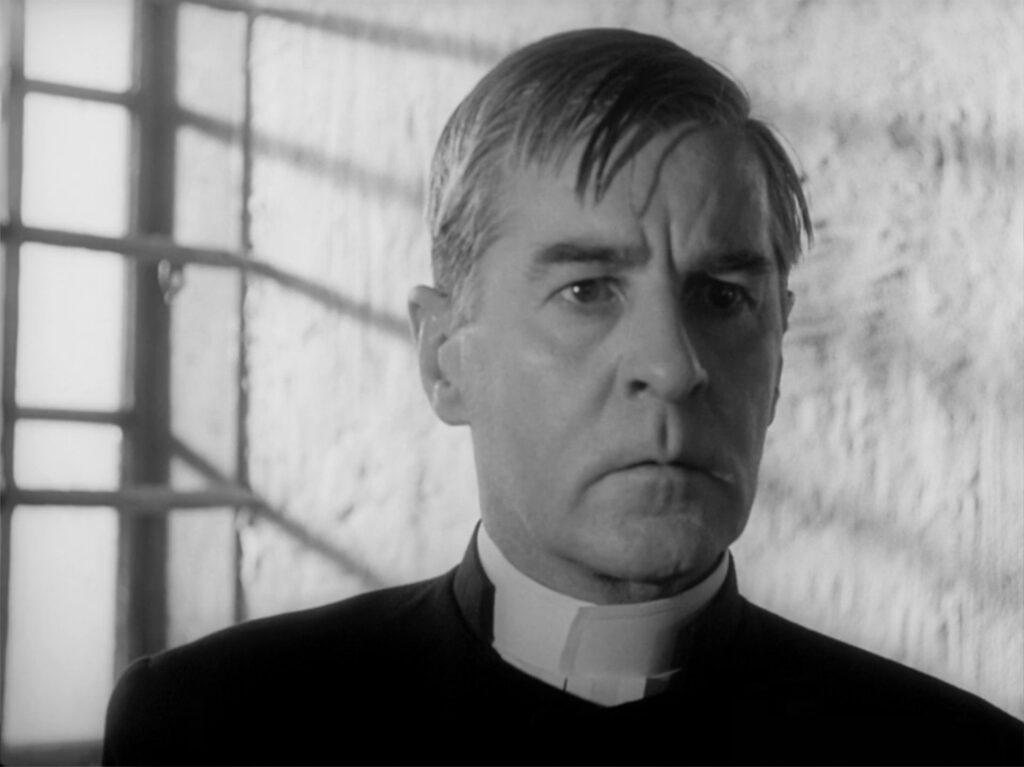
Winter Light
1963, directed by Ingmar Bergman
Fifty-four minutes into Winter Light, Märta gives Tomas aspirin and cough syrup in her schoolroom. It hardly looks like anything noteworthy, but it’s not the first time someone’s dispensed little white discs and dark sour liquid. The movie began with a communion service, and now Märta is repaying Tomas for the bread and wine, not only in a material sense but in the spirit of communion, trying to nourish his spirit as well as his body. Given that the movie’s real title is The Communicants (Nattvardsgästerna in Swedish), it would appear that the symmetry between both scenes is not only intentional but also important.
In fact the difference between Tomas Eriksson’s rather cold eucharist service and Märta Lundberg’s warmly given medicine opens the fault line around which the movie’s argument is built. It’s the same difference that defines the arc between the two masses that bracket Winter Light: the opening mass at the Mittsunda church where Tomas speaks of the night Christ was betrayed, and the closing mass at Frostnäs where he speaks of the glory of creation. Describing the arc this way gives us a glimmer of the movie’s purpose, and if we watch Winter Light with close attention to its structure we can appreciate the miraculous effect it achieves in such an unassuming ending.
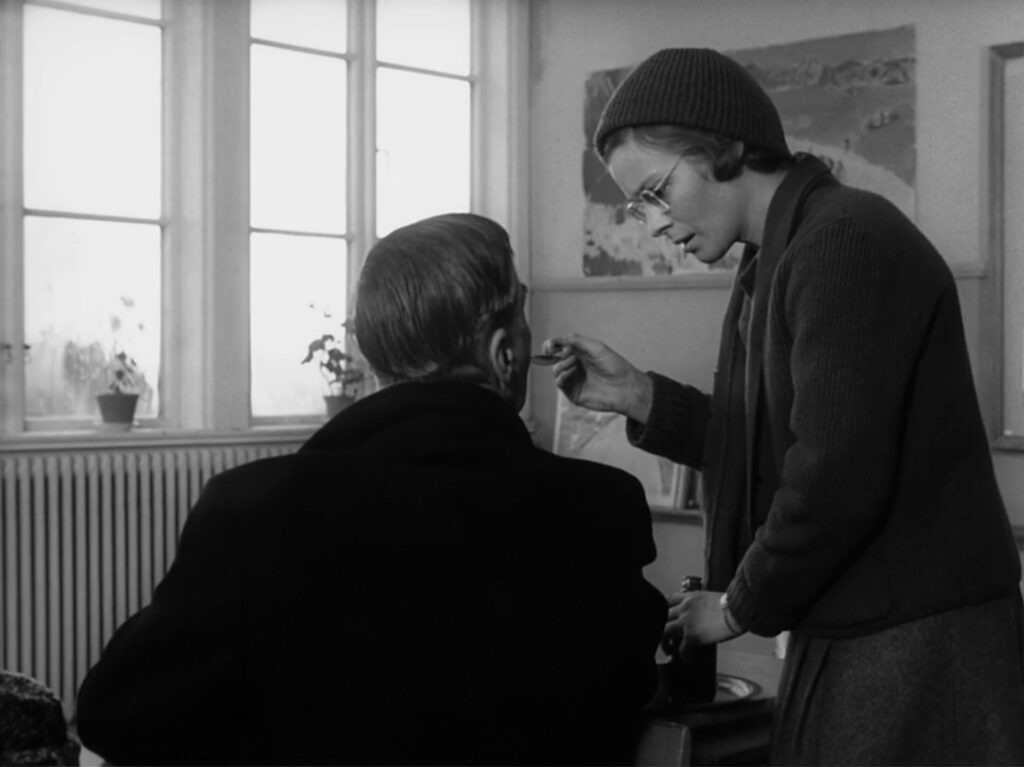
The symmetry in Winter Light runs deep. As the twin communion services and two masses hint at, the movie falls roughly into two parallel halves, and the hinge between them points to the movie’s understanding of religion. About halfway through, right after Jonas leaves and Tomas despairs of reaching his anguished parishioner, the pastor asks the same question Christ asked from the cross: “My God, why have you forsaken me?” But at the moment he asks it, he also gets his answer, which he will not comprehend until the final minutes. The answer comes pouring in around him even before the desperate words reach his lips, and he turns toward the window where the low winter sun floods the sacristy. The intense light bathes his face, but he is not yet ready to hear his question answered, so he turns away.
Bracketed by the two masses, Winter Light is roughly palindromic, and therefore the counterpart to the light at the sacristy window follows close behind. When Tomas goes down to the river to attend to Jonas’s dead body, the rapids fill the air with a steady white noise. If the sunlight in the window is a visual correlative to God’s presence reminding Tomas he is not abandoned, the rapids are the voice of God telling him the same thing. Together these signs reveal to us what Tomas fails to see until the end, that he has been looking for God in the wrong place.
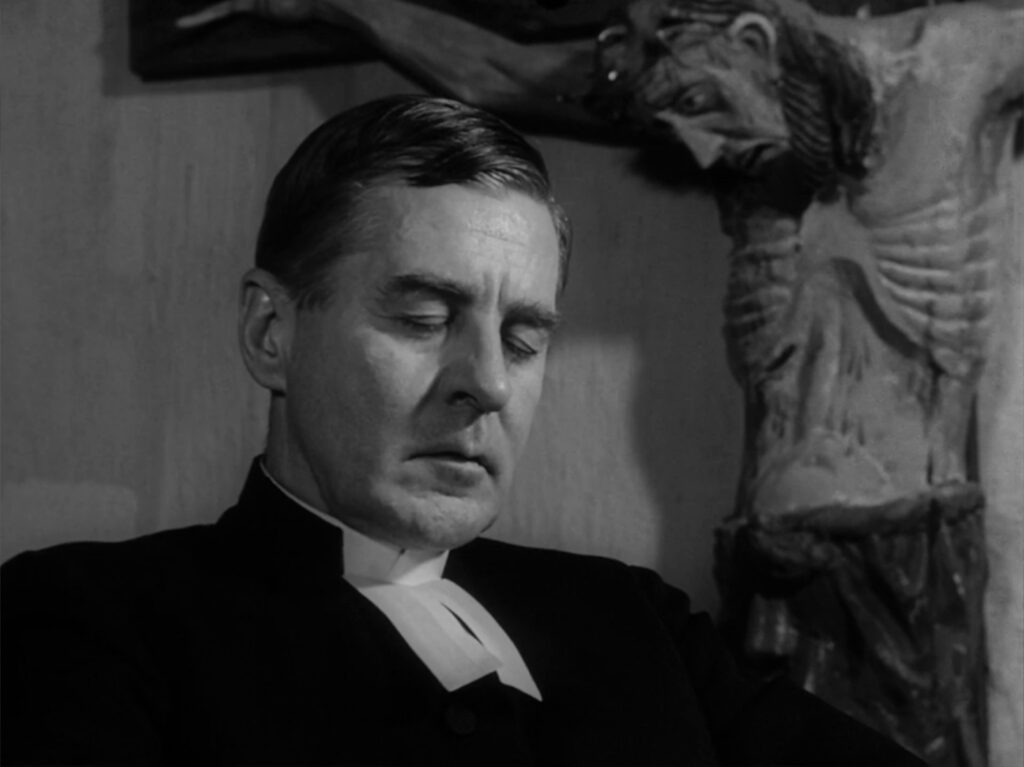
The opening mass says much about Tomas, but more importantly it describes a general fault that limits Christianity as a whole. In addition to the pastor’s stern demeanor and the words that speak of Christ’s betrayal, the Mittsunda church is filled with morbid images of suffering and death: a gruesome crucifix, a wall painting of a hooded skeleton with a chessboard, a skull and crossbones. The altarpiece is centered around God the Father holding the cross with his crucified son nailed to it. Tomas delivers the film’s first lines with eyes downcast, facing away from his congregation. As the sexton Algot will later suggest, Christianity’s emphasis on physical suffering, and its concomitant stress on sin and guilt, is counterproductive to faith because it distances man from God. Märta has to remind Tomas that the eucharist is supposed to be a love feast.
Even during its first few lines Winter Light reveals the alternative to a religion that fetishizes suffering. As Tomas recites the Lord’s Prayer the film cuts outside to three views of the church set among trees, snow, and a layer of mist floating above a placid river. The authoritative reverberation of the pastor’s voice diminishes for a moment, giving way to a more natural outdoor tone as if the church walls have vanished. Like the sunlight in the window and the roar of the rapids, God’s presence is more accessible through nature than inside the church.
The gulf between the wonders of nature and Tomas’s nightmare religion with its “spider God” is only part of the distinction Winter Light makes between the actual Christianity we’ve inherited and the potential for a religion that lives up to Christ’s teaching. Between Tomas and Märta the movie also distinguishes between a harsh, authoritative, masculine religion and a more feminine, loving religion that should replace it. After the schoolroom Märta takes over the steering wheel, driving Tomas to Karin Persson’s house and then to Frostnäs church. The switch is symbolic, as she suddenly becomes the more influential figure. Earlier she had recoiled when Tomas emerged from the sacristy after his desperate question to God, as if thrust backward by the diabolical force of his despair, but when she kneels down to pray for him at Frostnäs, the supernatural influence moves in the opposite direction. Again she’s in the nave while he’s in the sacristy, and again she’s backlit while he’s bathed in light, but the cut this time finds them facing in the same direction, almost in identical positions, and now the power of her prayer recharges his faith as he begins the 3:00 mass. It’s as if he’s come around to her point of view.
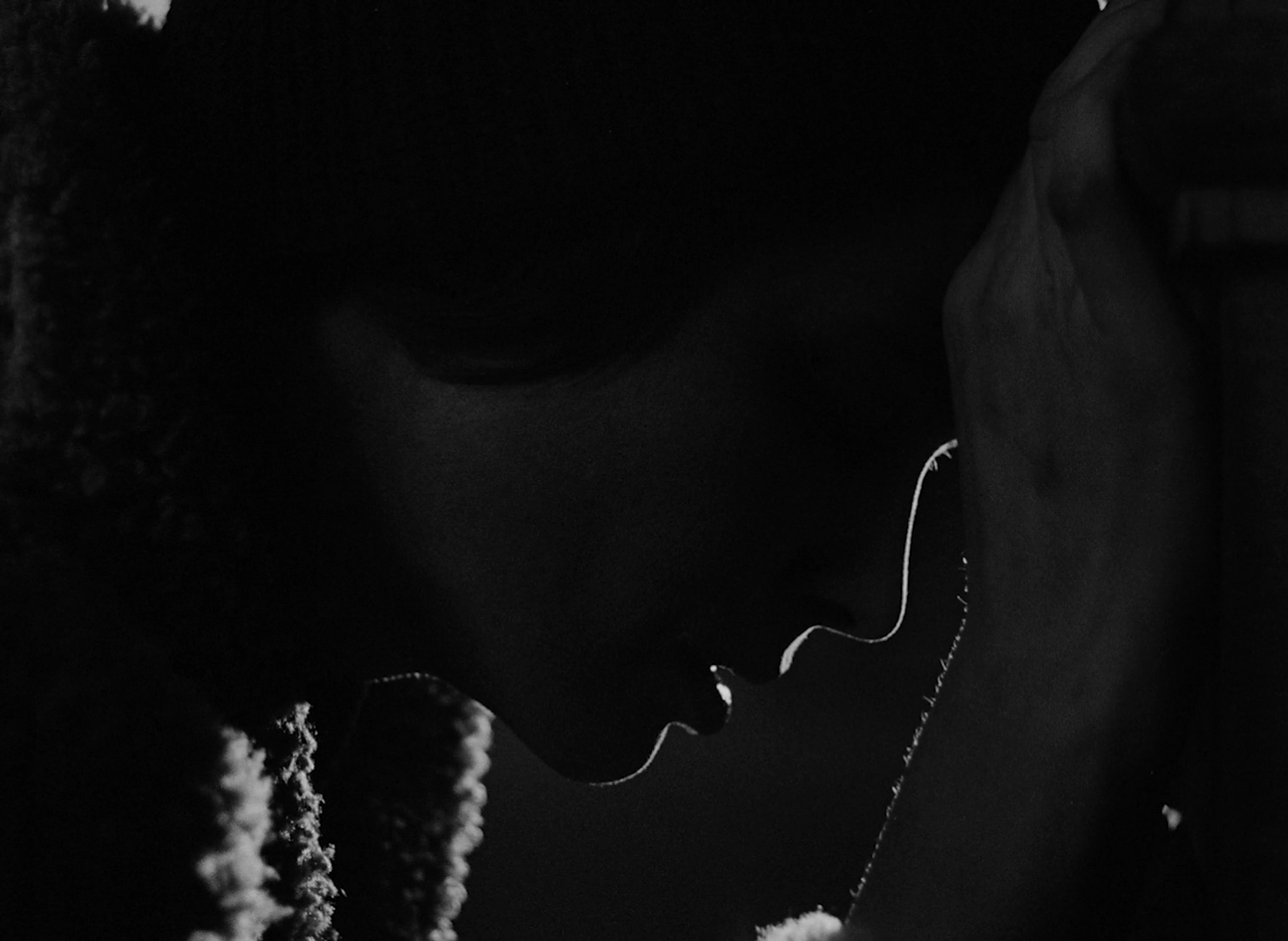
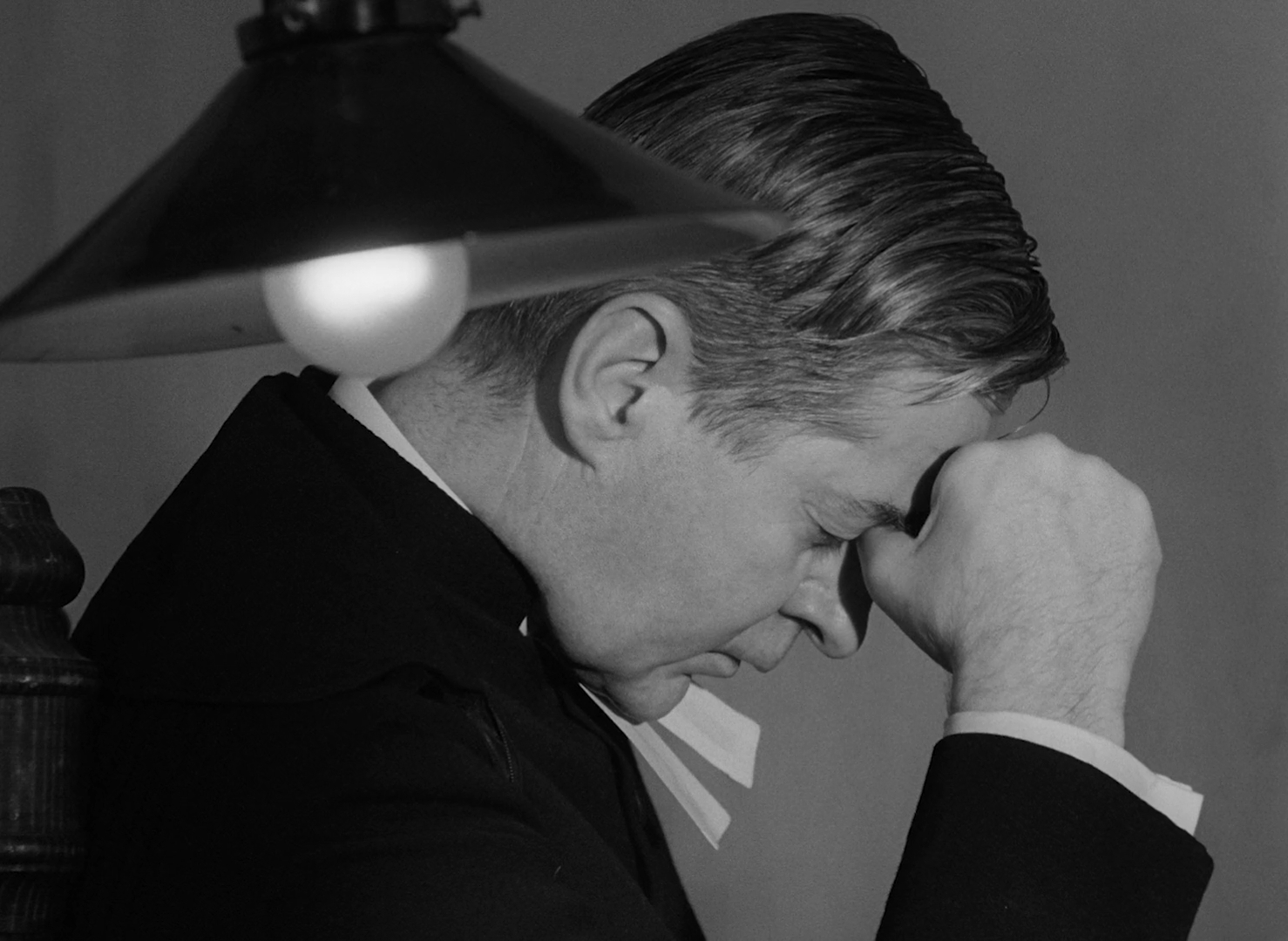
The movie adds further symbolic weight to the distinction by consistently showing enlightenment coming from a horizontal direction, in contrast to a hierarchical religion where it comes from above. The sunlight in the window, the sound of the rapids, Algot’s conversation, and Märta’s prayer all come to Tomas from the side. At the schoolroom he tries to dissuade Märta from coming to Frostnäs with him, but when he opens the door to leave – after cruelly rejecting her affection – he suddenly changes his mind and invites her along. The transformative influence comes again from nature, from his sudden exposure to the outdoors, but it also comes from the side through the partly opened door.
When Märta gives Tomas her “communion” of aspirin and cough syrup, the fact that it takes place in a classroom suggests that there’s also a lesson in it. Winter Light argues that Christianity has erred by putting Christ’s suffering and death at the center of its identity… after all its chief symbol is a cross. By doing so, Christians have shifted emphasis away from the idea of communion, the love feast that rightly forms the center of their ritual. The word “communion” has a broad connotation of spiritual intercourse, both among humans and between humans and God. When Tomas speaks of “God’s silence” he means a lack of communion with the deity, a problem that the more agnostic Märta ironically doesn’t share. Their respective understandings of communion are mirrored in their relationship – Tomas insists he doesn’t love her, speaking of love as if it’s a condition that just happens, whereas she understands that love is an active verb, a willed commitment.
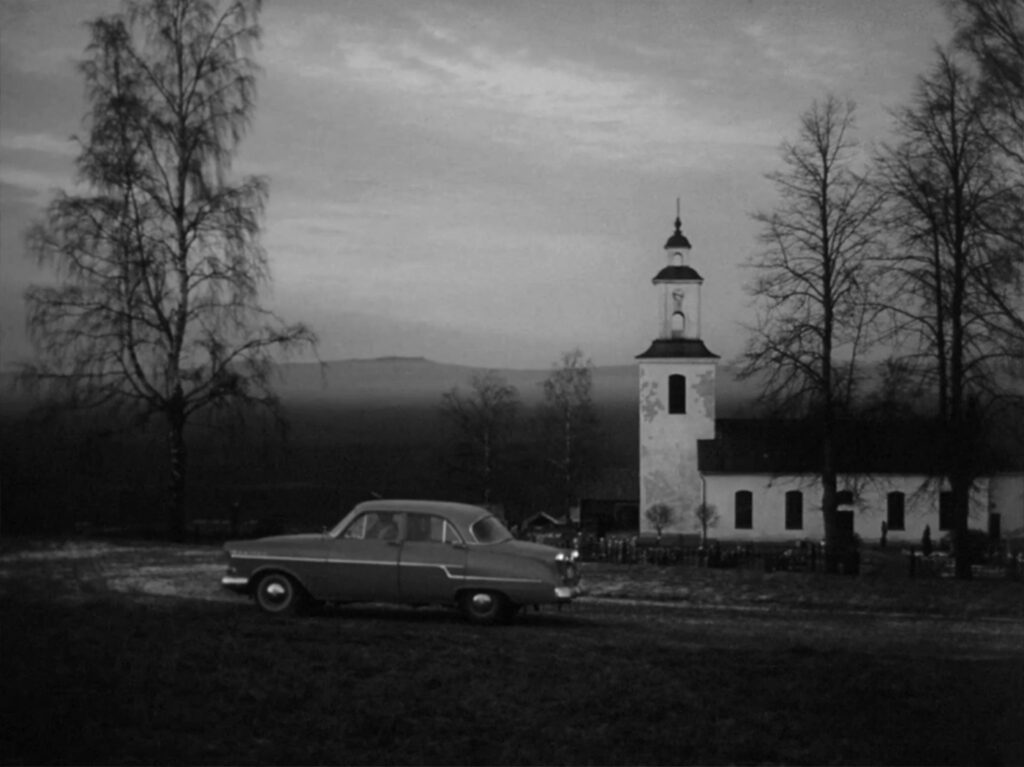
Each major character in Winter Light has a physical affliction: Tomas has the flu, Märta has eczema, Jonas suffers depression, Karin is pregnant, the organist is an alcoholic, and Algot is a hunchback (fittingly, his shoulder protrudes like an angel’s wing). For Tomas however, the ordinary agony of life is compounded by a crisis of faith that stems from his lack of communion with God and others. His story parallels the agony of Christ before his death. Algot supposes that Christ’s suffering lasted about four hours, and Winter Light happens to span the exact same four hours traditionally associated with Christ’s passion… the bells in the opening credits strike eleven times, and the mass at Frostnäs begins at 3:00 p.m. X-shaped crosses appear from time to time – the crossbones, the schoolhouse door frame, and the railroad crossing sign – representing the shape of the cross while Christ is carrying it. Algot’s speech points out that Tomas’s loneliness and his feeling of living a lie resemble Christ’s experience.
Softened at the end by Algot’s reflections, Märta’s prayer, and his own hard experience over the past four hours, Tomas is finally ready for an epiphany. Bergman is too good a director to make a sentimental fuss about it – we have to read the signs ourselves, but in the last moments the whole argument comes together in a quiet yet total reversal. The altarpiece now features the infant Jesus in his mother’s lap; Tomas faces the congregation with his eyes uplifted; and when he begins the mass – “Holy, holy, holy is the Lord of Hosts. The whole earth is full of His glory” – he at last finds sanctity in nature.
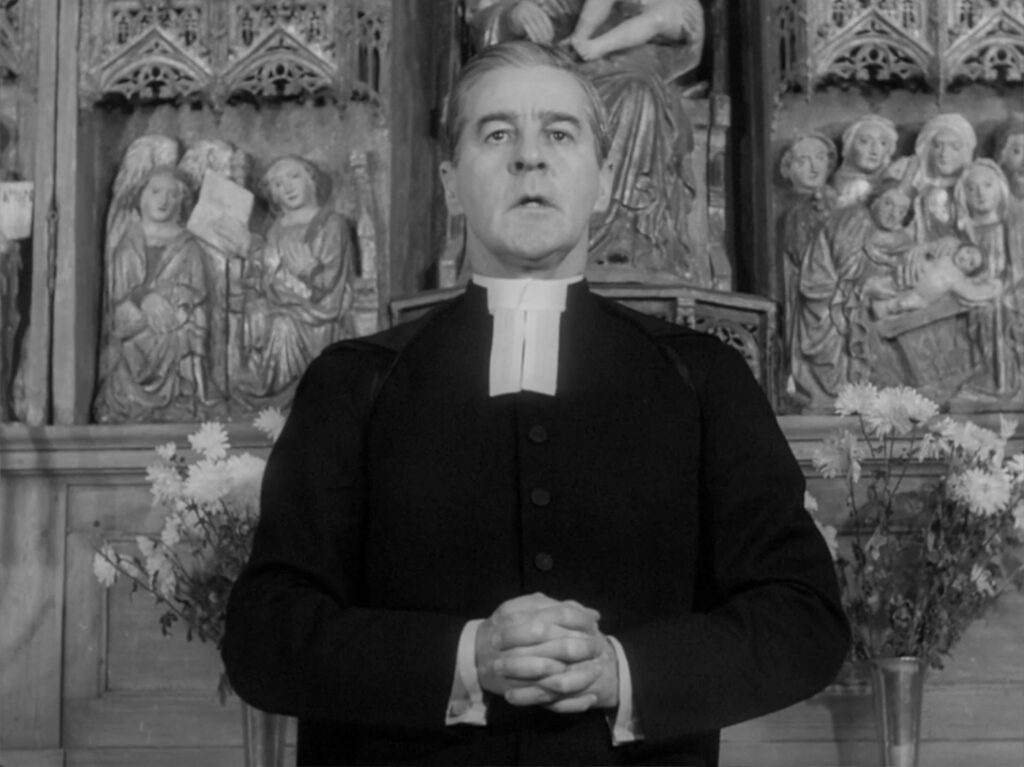
Winter Light, then, is an argument against a Christianity that puts the messenger before the message. By placing Christ and the crucifixion at the center of its faith, Christianity neglects Christ’s exhortation to live in the world radiating love rather than retreating into self-reproach. Instead of concentrating on the holiness of the church, the saints, and Christ, those last words tell us that we should regard the whole earth as holy and live accordingly.
CONNECTIONS:
Earth – Character named after the apostle Thomas; secular metaphor for the eucharist
Late Spring – Ceremony in opening scene interrupted by shots of nature; guiding spirit of ceremony undercut or at least altered over span of film, which ends with another ceremony
Diary of a Country Priest – Statement of abandonment by God; priest’s faith tested by a suicide; argument against a brand of religion that deemphasizes love; eucharist secularized in priest’s diet or medicine; Christ’s passion as a template for the protagonist’s experience
The Night of the Hunter – Contrast between two different versions of Christianity
The Seventh Seal – Image of Death with a chessboard
Knife in the Water – Significance in a man and a woman switching driver’s role
Vivre sa vie – Parallel arguments about art and religion, that it’s idolatry to put the messenger above the message
Simón of the Desert – Critique of religion’s failure to achieve its ideal of communion
Blow-Up – Character named after the apostle Thomas
2 or 3 Things I Know About Her – Palindromic film with a transformation in the protagonist
The Structure of Crystal – Intimate winter setting; contest between two points of view; symbolically important switch of drivers
Cries and Whispers – Minister of weak faith who represents a religion obsessed with suffering
The Devil Probably – Wordless voice of God personified in a sound effect
Nostalghia – Sign of God’s presence when it feels lacking (light in window, feather)
Breaking the Waves – Argument against a version of Christianity that emphasizes death to the detriment of life and love